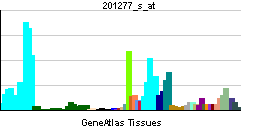HNRPAB
| Heterogeneous nuclear ribonucleoprotein A/B | |||||||||||
|---|---|---|---|---|---|---|---|---|---|---|---|
| Identifiers | |||||||||||
| Symbols | HNRPAB ; ABBP1 | ||||||||||
| External IDs | Template:OMIM5 Template:MGI HomoloGene: 74950 | ||||||||||
| |||||||||||
| RNA expression pattern | |||||||||||
 | |||||||||||
| More reference expression data | |||||||||||
| Orthologs | |||||||||||
| Template:GNF Ortholog box | |||||||||||
| Species | Human | Mouse | |||||||||
| Entrez | n/a | n/a | |||||||||
| Ensembl | n/a | n/a | |||||||||
| UniProt | n/a | n/a | |||||||||
| RefSeq (mRNA) | n/a | n/a | |||||||||
| RefSeq (protein) | n/a | n/a | |||||||||
| Location (UCSC) | n/a | n/a | |||||||||
| PubMed search | n/a | n/a | |||||||||
Heterogeneous nuclear ribonucleoprotein A/B, also known as HNRPAB, is a human gene.[1]
This gene belongs to the subfamily of ubiquitously expressed heterogeneous nuclear ribonucleoproteins (hnRNPs). The hnRNPs are produced by RNA polymerase II and are components of the heterogeneous nuclear RNA (hnRNA) complexes. They are associated with pre-mRNAs in the nucleus and appear to influence pre-mRNA processing and other aspects of mRNA metabolism and transport. While all of the hnRNPs are present in the nucleus, some seem to shuttle between the nucleus and the cytoplasm. The hnRNP proteins have distinct nucleic acid binding properties. The protein encoded by this gene, which binds to one of the components of the multiprotein editosome complex, has two repeats of quasi-RRM (RNA recognition motif) domains that bind to RNAs. Two alternatively spliced transcript variants encoding different isoforms have been described for this gene.[1]
References
Further reading
- Khan FA, Jaiswal AK, Szer W (1991). "Cloning and sequence analysis of a human type A/B hnRNP protein". FEBS Lett. 290 (1–2): 159–61. PMID 1717314.
- Maruyama K, Sugano S (1994). "Oligo-capping: a simple method to replace the cap structure of eukaryotic mRNAs with oligoribonucleotides". Gene. 138 (1–2): 171–4. PMID 8125298.
- Gress TM, Müller-Pillasch F, Geng M; et al. (1996). "A pancreatic cancer-specific expression profile". Oncogene. 13 (8): 1819–30. PMID 8895530.
- Lau PP, Zhu HJ, Nakamuta M, Chan L (1997). "Cloning of an Apobec-1-binding protein that also interacts with apolipoprotein B mRNA and evidence for its involvement in RNA editing". J. Biol. Chem. 272 (3): 1452–5. PMID 8999813.
- Suzuki Y, Yoshitomo-Nakagawa K, Maruyama K; et al. (1997). "Construction and characterization of a full length-enriched and a 5'-end-enriched cDNA library". Gene. 200 (1–2): 149–56. PMID 9373149.
- Hay DC, Kemp GD, Dargemont C, Hay RT (2001). "Interaction between hnRNPA1 and IkappaBalpha is required for maximal activation of NF-kappaB-dependent transcription". Mol. Cell. Biol. 21 (10): 3482–90. doi:10.1128/MCB.21.10.3482-3490.2001. PMID 11313474.
- Lau PP, Chang BH, Chan L (2001). "Two-hybrid cloning identifies an RNA-binding protein, GRY-RBP, as a component of apobec-1 editosome". Biochem. Biophys. Res. Commun. 282 (4): 977–83. doi:10.1006/bbrc.2001.4679. PMID 11352648.
- Gallouzi IE, Brennan CM, Steitz JA (2001). "Protein ligands mediate the CRM1-dependent export of HuR in response to heat shock". RNA. 7 (9): 1348–61. PMID 11565755.
- Andersen JS, Lyon CE, Fox AH; et al. (2002). "Directed proteomic analysis of the human nucleolus". Curr. Biol. 12 (1): 1–11. PMID 11790298.
- Percipalle P, Jonsson A, Nashchekin D; et al. (2002). "Nuclear actin is associated with a specific subset of hnRNP A/B-type proteins". Nucleic Acids Res. 30 (8): 1725–34. PMID 11937625.
- Angenstein F, Evans AM, Settlage RE; et al. (2002). "A receptor for activated C kinase is part of messenger ribonucleoprotein complexes associated with polyA-mRNAs in neurons". J. Neurosci. 22 (20): 8827–37. PMID 12388589.
- Strausberg RL, Feingold EA, Grouse LH; et al. (2003). "Generation and initial analysis of more than 15,000 full-length human and mouse cDNA sequences". Proc. Natl. Acad. Sci. U.S.A. 99 (26): 16899–903. doi:10.1073/pnas.242603899. PMID 12477932.
- Fomenkov A, Huang YP, Topaloglu O; et al. (2003). "P63 alpha mutations lead to aberrant splicing of keratinocyte growth factor receptor in the Hay-Wells syndrome". J. Biol. Chem. 278 (26): 23906–14. doi:10.1074/jbc.M300746200. PMID 12692135.
- Ota T, Suzuki Y, Nishikawa T; et al. (2004). "Complete sequencing and characterization of 21,243 full-length human cDNAs". Nat. Genet. 36 (1): 40–5. doi:10.1038/ng1285. PMID 14702039.
- Zhang S, Schlott B, Görlach M, Grosse F (2004). "DNA-dependent protein kinase (DNA-PK) phosphorylates nuclear DNA helicase II/RNA helicase A and hnRNP proteins in an RNA-dependent manner". Nucleic Acids Res. 32 (1): 1–10. doi:10.1093/nar/gkg933. PMID 14704337.
- Gao C, Guo H, Wei J; et al. (2004). "S-nitrosylation of heterogeneous nuclear ribonucleoprotein A/B regulates osteopontin transcription in endotoxin-stimulated murine macrophages". J. Biol. Chem. 279 (12): 11236–43. doi:10.1074/jbc.M313385200. PMID 14722087.
- Gerhard DS, Wagner L, Feingold EA; et al. (2004). "The status, quality, and expansion of the NIH full-length cDNA project: the Mammalian Gene Collection (MGC)". Genome Res. 14 (10B): 2121–7. doi:10.1101/gr.2596504. PMID 15489334.
- Ong SE, Mittler G, Mann M (2005). "Identifying and quantifying in vivo methylation sites by heavy methyl SILAC". Nat. Methods. 1 (2): 119–26. doi:10.1038/nmeth715. PMID 15782174.
- Beausoleil SA, Villén J, Gerber SA; et al. (2006). "A probability-based approach for high-throughput protein phosphorylation analysis and site localization". Nat. Biotechnol. 24 (10): 1285–92. doi:10.1038/nbt1240. PMID 16964243.
- Ewing RM, Chu P, Elisma F; et al. (2007). "Large-scale mapping of human protein-protein interactions by mass spectrometry". Mol. Syst. Biol. 3: 89. doi:10.1038/msb4100134. PMID 17353931.
| This protein-related article is a stub. You can help Wikipedia by expanding it. |